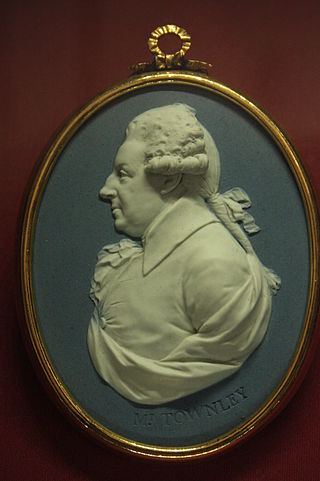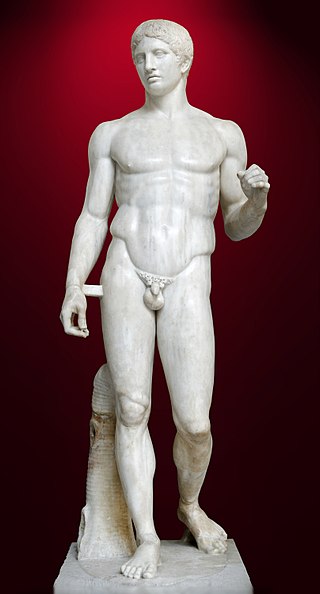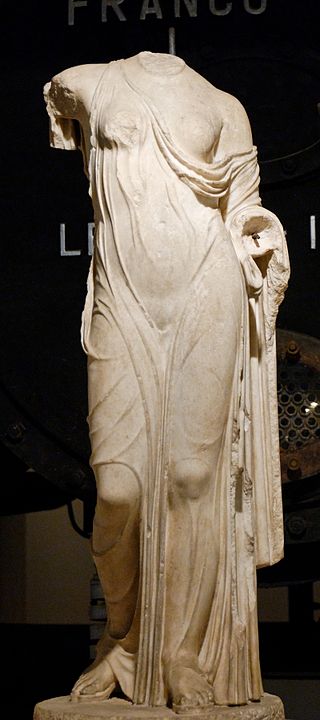
The British Museum is a public museum dedicated to human history, art and culture located in the Bloomsbury area of London. Its permanent collection of eight million works is the largest in the world. It documents the story of human culture from its beginnings to the present. The British Museum was the first public national museum to cover all fields of knowledge.

In Greek mythology, Hypnos, also spelled Hypnus, is the personification of sleep; the Roman equivalent is known as Somnus. His name is the origin of the word hypnosis. Pausanias wrote that Hypnos was the dearest friend of the Muses.

Praxiteles of Athens, the son of Cephisodotus the Elder, was the most renowned of the Attica sculptors of the 4th century BC. He was the first to sculpt the nude female form in a life-size statue. While no indubitably attributable sculpture by Praxiteles is extant, numerous copies of his works have survived; several authors, including Pliny the Elder, wrote of his works; and coins engraved with silhouettes of his various famous statuary types from the period still exist.

Charles Townley FRS was a wealthy English country gentleman, antiquary and collector, a member of the Towneley family. He travelled on three Grand Tours to Italy, buying antique sculpture, vases, coins, manuscripts and Old Master drawings and paintings. Many of the most important pieces from his collection, especially the Townley Marbles are now in the British Museum's Department of Greek and Roman Antiquities. The marbles were overshadowed at the time, and still today, by the Elgin Marbles.

Polykleitos was an ancient Greek sculptor, active in the 5th century BCE. Alongside the Athenian sculptors Pheidias, Myron and Praxiteles, he is considered as one of the most important sculptors of classical antiquity. The 4th century BCE catalogue attributed to Xenocrates, which was Pliny's guide in matters of art, ranked him between Pheidias and Myron. He is particularly known for his lost treatise, the Canon of Polykleitos, which set out his mathematical basis of an idealised male body shape.

Lysippos was a Greek sculptor of the 4th century BC. Together with Scopas and Praxiteles, he is considered one of the three greatest sculptors of the Classical Greek era, bringing transition into the Hellenistic period. Problems confront the study of Lysippos because of the difficulty in identifying his style in the copies which survive. Not only did he have a large workshop and many disciples in his immediate circle, but there is understood to have been a market for replicas of his work, supplied from outside his circle, both in his lifetime and later in the Hellenistic and Roman periods. The Victorious Youth or Getty bronze, which resurfaced around 1972, has been associated with him.

The Villa of the Papyri was an ancient Roman villa in Herculaneum, in what is now Ercolano, southern Italy. It is named after its unique library of papyri scrolls, discovered in 1750. The Villa was considered to be one of the most luxurious houses in all of Herculaneum and in the Roman world. Its luxury is shown by its exquisite architecture and by the large number of outstanding works of art discovered, including frescoes, bronzes and marble sculpture which constitute the largest collection of Greek and Roman sculptures ever discovered in a single context.

The National Archaeological Museum of Naples is an important Italian archaeological museum, particularly for ancient Roman remains. Its collection includes works from Greek, Roman and Renaissance times, and especially Roman artifacts from the nearby Pompeii, Stabiae and Herculaneum sites. From 1816 to 1861, it was known as Real Museo Borbonico.

The sculpture of ancient Greece is the main surviving type of fine ancient Greek art as, with the exception of painted ancient Greek pottery, almost no ancient Greek painting survives. Modern scholarship identifies three major stages in monumental sculpture in bronze and stone: the Archaic, Classical (480–323) and Hellenistic. At all periods there were great numbers of Greek terracotta figurines and small sculptures in metal and other materials.

The Discobolus by Myron is an ancient Greek sculpture completed at the start of the Classical period in around 460–450 BC that depicts an ancient Greek athlete throwing a discus. Its Greek original in bronze lost, the work is known through numerous Roman copies, both full-scale ones in marble, which is cheaper than bronze, such as the Palombara Discobolus, the first to be recovered, and smaller scaled versions in bronze.

The Capitoline Museums are a group of art and archaeological museums in Piazza del Campidoglio, on top of the Capitoline Hill in Rome, Italy. The historic seats of the museums are Palazzo dei Conservatori and Palazzo Nuovo, facing on the central trapezoidal piazza in a plan conceived by Michelangelo in 1536 and executed over a period of more than 400 years.

The study of Roman sculpture is complicated by its relation to Greek sculpture. Many examples of even the most famous Greek sculptures, such as the Apollo Belvedere and Barberini Faun, are known only from Roman Imperial or Hellenistic "copies". At one time, this imitation was taken by art historians as indicating a narrowness of the Roman artistic imagination, but, in the late 20th century, Roman art began to be reevaluated on its own terms: some impressions of the nature of Greek sculpture may in fact be based on Roman artistry.

The Chimera of Arezzo is regarded as the best example of ancient Etruscan art. The British art historian David Ekserdjian described the sculpture as "one of the most arresting of all animal sculptures and the supreme masterpiece of Etruscan bronze-casting". Made entirely of bronze and measuring 78.5 cm high with a length of 129 cm, it was found alongside a small collection of other bronze statues in Arezzo, an ancient Etruscan and Roman city in Tuscany. The statue was originally part of a larger sculptural group representing a fight between a chimera and the Greek hero Bellerophon. This sculpture is likely to have been created as a votive offering to the Etruscan god Tinia and is held by the National Archaeological Museum, Florence.

Apoxyomenos is one of the conventional subjects of ancient Greek votive sculpture; it represents an athlete, caught in the familiar act of scraping sweat and dust from his body with the small curved instrument that the Greeks called a stlengis and the Romans a strigil.

The Antikythera Ephebe, registered as: Bronze statue of a youth in the museum collections, is a bronze statue of a young man of languorous grace that was found in 1900 by sponge-divers in the area of the ancient Antikythera shipwreck off the island of Antikythera, Greece. It was the first of the series of Greek bronze sculptures that the Aegean and Mediterranean yielded up in the twentieth century which have fundamentally altered the modern view of ancient Greek sculpture. The wreck site, which is dated about 70–60 BC, also yielded the Antikythera mechanism, a characterful head of a Stoic philosopher, and a hoard of coins. The coins included a disproportionate quantity of Pergamene cistophoric tetradrachms and Ephesian coins, leading scholars to surmise that it had begun its journey on the Ionian coast, perhaps at Ephesus; none of its recovered cargo has been identified as from mainland Greece.

The Venus Genetrix is a sculptural type which shows the Roman goddess Venus in her aspect of Genetrix, as she was honoured by the Julio-Claudian dynasty of Rome, which claimed her as their ancestor. Contemporary references identify the sculptor as a Greek named Arcesilaus. The statue was set up in Julius Caesar's new forum, probably as the cult statue in the cella of his temple of Venus Genetrix. Through this historical chance, a Roman designation is applied to an iconological type of Aphrodite that originated among the Greeks.

The Meroë Head, or Head of Augustus from Meroë, is a larger-than-life-size bronze head depicting the first Roman emperor, Augustus, that was found in the ancient Nubian site of Meroë in modern Sudan in 1910. Long admired for its striking appearance and perfect proportions, it is now part of the British Museum's collection. It was looted from Roman Egypt in 24 BC by the forces of queen Amanirenas of Kush and brought back to Meroë, where it was buried beneath the staircase of a temple.

The Vaison Diadumenos is a life size marble statue of an athlete found at the Roman city of Vaison, southern France. Since 1870, it has been part of the British Museum's collection.
Civitella d'Arna is a frazione of the comune (municipality) of Perugia in central Italy, and the Ancient city and former bishopric Arna, which remains a Latin Catholic titular see.
The Cleveland Apollo is a 4th-century BCE life-size bronze Ancient Greek statue, now in the Cleveland Museum of Art. It acquired it in 2004 using the Severance and Greta Millikin Purchase Fund. The Museum attributed the piece to Praxiteles. Technical features of the Cleveland Apollo are consistent with the Late Classical Period, during Praxiteles's lifetime. Scientific investigation of the sculpture and the separated parts shows that they are from the same casting. The age of the casting is still under review as of 2017. Scholarly investigation has raised several questions about it being a Praxiteles original.


















